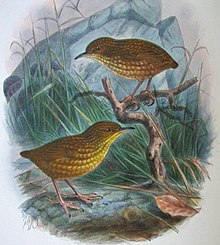Stub tails
| Stub tails | ||||||||||||
|---|---|---|---|---|---|---|---|---|---|---|---|---|

Rock slip ( Xenicus gilviventris ) |
||||||||||||
| Systematics | ||||||||||||
|
||||||||||||
| Scientific name of the subordination | ||||||||||||
| Acanthisitti | ||||||||||||
| Wolters , 1977 | ||||||||||||
| Scientific name of the family | ||||||||||||
| Acanthisittidae | ||||||||||||
| Sundevall , 1872 |
The stubby tails (Acanthisittidae), formerly known as Maori panties or New Zealand panties, are a family from the order of the passerine birds (Passeriformes) endemic to New Zealand . They are the basic sister group of all other passerine birds. Today there are only two species left ; five more have died out.


description
Stubby tails are similar to wrens in their physique , but they are not closely related to them. They are very small birds, only 8 to 10 centimeters in length. Their physique is short and their tail and neck are very short. Their wings are short and rounded, and their ability to fly is poorly developed. The legs are strong, the toes are long and thin. The beak is long and pointed, sometimes it is slightly curved upwards. The color of the plumage varies from yellowish-brown to greenish, the underside is lighter, often white or gray. The sexual dimorphism is not very pronounced, but females are usually more dull in color.
Way of life
These birds are mostly found in forests and rocky terrain. They mostly roam the ground or climb tree trunks, where they look for insects, their main food. Their behavior is sometimes compared to that of rodents or insectivores ; since these animals were not originally found in New Zealand, they may have occupied their ecological niche . These birds are monogamous and are predominantly ground-breeders , but the green hatch can also build its nest on trees. The young animals are fed by both sexes.
Systematics
The stub tails were previously assigned to the screeching birds , but DNA comparisons show that they are outside this taxon and represent the basal sister taxon of all other passerine birds.
- Genus Acanthisitta
- Green panties or grenadiers ( Acanthisitta chloris )
- Genus Xenicus
- Rock slip ( Xenicus gilviventris )
- † Forest panties ( Xenicus longipes )
- † Genus Traversia
- † Stephenschlüpfer ( Traversia lyalli )
In addition, several subfossil species are known that became extinct before the arrival of Europeans:
threat
As ground-brooders with hardly any natural enemies, the stubby tails were particularly susceptible to disturbances from the introduction of neozoa . The Pacific rat was introduced even before the arrival of the Europeans , which resulted in several species being exterminated or pushed back to small islands. With the Europeans came other rats , mongooses , cats and other predators for whom the animals were easy prey. The Stephens Island Wren was the late 19th century by the cat of the lighthouse keeper on Stephens Iceland (New Zealand) eradicated the bushwren disappeared in the second half of the 20th century. Two species still live today, the threatened rock slip and the still relatively common green slip .
Individual evidence
- ↑ a b c Illustrations by John Gerrard Keulemans , from A History of the Birds of New Zealand, 1905
- ↑ Ericson, PGP, L. Christidis, A. Cooper, M. Irestedt, J. Jackson, US Johansson, & JA Norman. 2002. A Gondwanan origin of passerine birds supported by DNA sequences of the endemic New Zealand wrens. Proceedings of the Royal Society of London Series B 269: 235–241, PMC 1690883 (free full text)
- ^ F. Keith Barker, Alice Cibois, Peter Schikler, Julie Feinstein & Joel Cracraft: Phylogeny and diversification of the largest avian radiation. PNAS, July 27, 2004, Vol. 101, no.30, PDF
